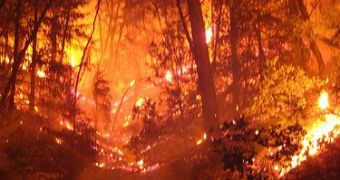Scientists analyzing the Earth's atmosphere have concluded that the atmospheric oxygen levels were much higher a few hundred million years ago, and that they vary along with the evolution of life. Scientists from the Royal Holloway, University of London and from The Field Museum in Chicago have published their research about the amount of oxygen there was in the past, in this week's “Nature Geoscience”.
Today the Earth's oxygen level is at 21%, but 400 million years ago it was much higher, according to scientists. They have revealed that the amount of charcoal preserved in ancient acidic peat wetlands, now transformed into coal, can tell how much oxygen there was in the past.
Until now, to estimate atmospheric oxygen levels, scientists used geochemical models. Even if this only lead to different results, they all agree that in the Late Paleozoic, levels of oxygen concentration in the atmosphere were much higher than today. Researchers believe that these high amounts of oxygen were linked to gigantism in some animals, mostly insects, like the dragonfly Meganeura monyi that had a wingspan of over two feet; oxygen might also have allowed vertebrates to colonize the land.
These huge levels of oxygen were mainly caused by the plants colonizing the land. As plants produce oxygen through photosynthesize and trap carbon into the ground through their roots, it is only normal for the oxygen levels to be very high. As for the burial of the carbon, it was particularly intense during the Late Paleozoic, when huge deposits of coal accumulated.
The major inconvenient with large amounts of oxygen is the extreme flammability of everything, even of the green wet leaves. As Dr Ian J Glasspool from The Field Museum explains, “Atmospheric oxygen concentration is strongly related to flammability. At levels below 15% wildfires could not have spread. However, at levels significantly above 25% even wet plants could have burned, while at levels around 30 to 35%, as have been proposed for the Late Paleozoic, wildfires would have been frequent and catastrophic.”
Professor Andrew C Scott from the Royal Holloway University of London along with other researchers, have discovered that for the past 50 million years, the level of charcoal in coal stabilized at concentrations of 4-8%, which corresponds with today's oxygen level, however they did not yet found the reason why this happened.
Still they say that during several periods in the Earth's history, the charcoal percentage was up to 70%. This means that fires were frequent and catastrophic, especially during the Carboniferous and Permian Periods some 320 to 250 million years ago and the Middle Cretaceous Period nearly 100 million years ago.
“It is interesting that these were times of major change in the evolution of vegetation on land with the evolution and spread of new plant groups, the conifers in the late Carboniferous and flowering plants in the Cretaceous,”adds professor Scott. “The mystery to us is why oxygen levels appear to have more or less stabilized about 50 million years ago.”

 14 DAY TRIAL //
14 DAY TRIAL //